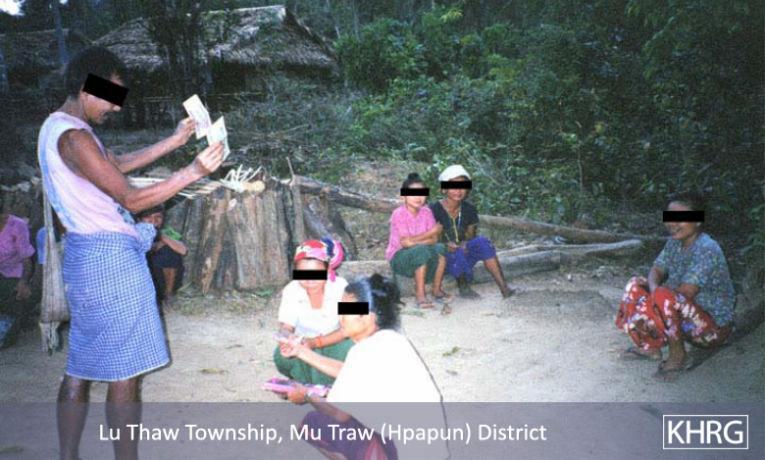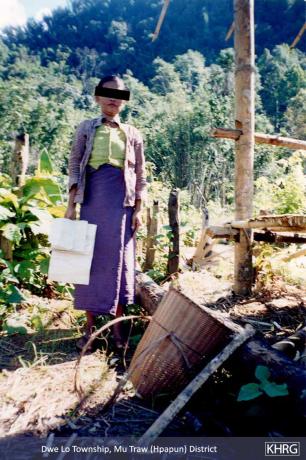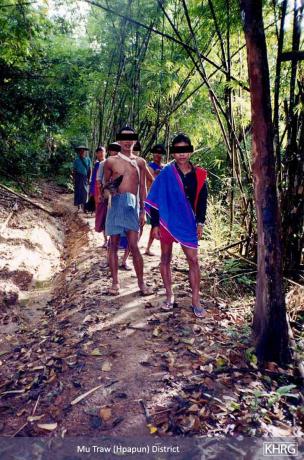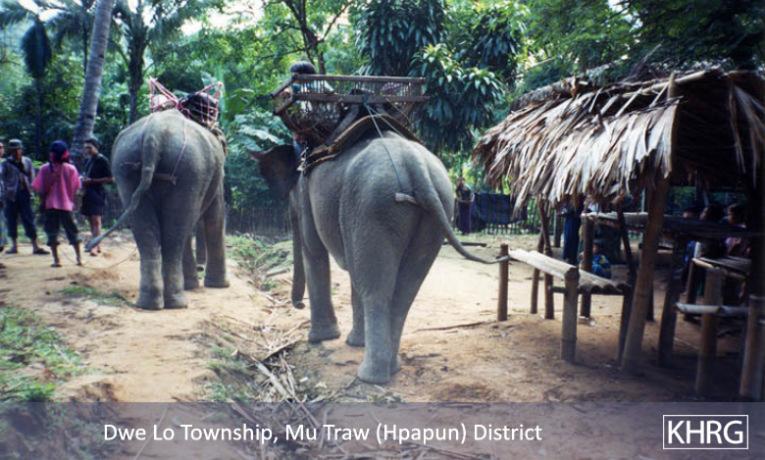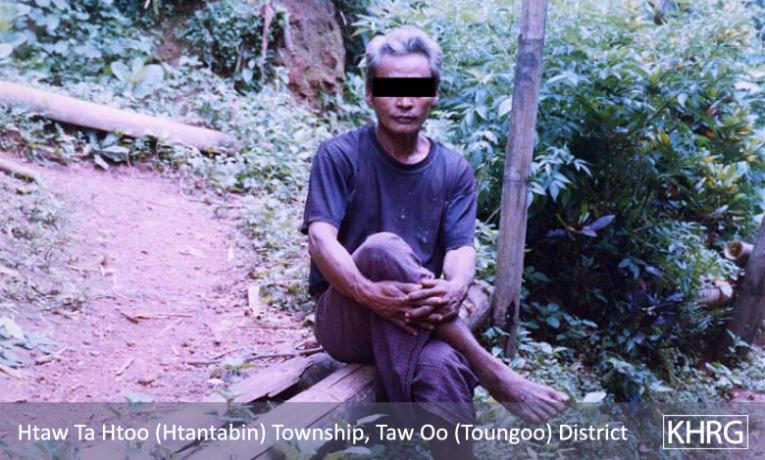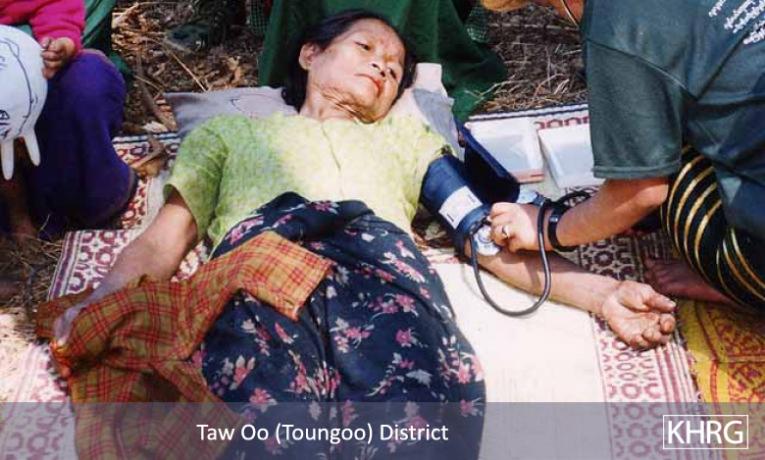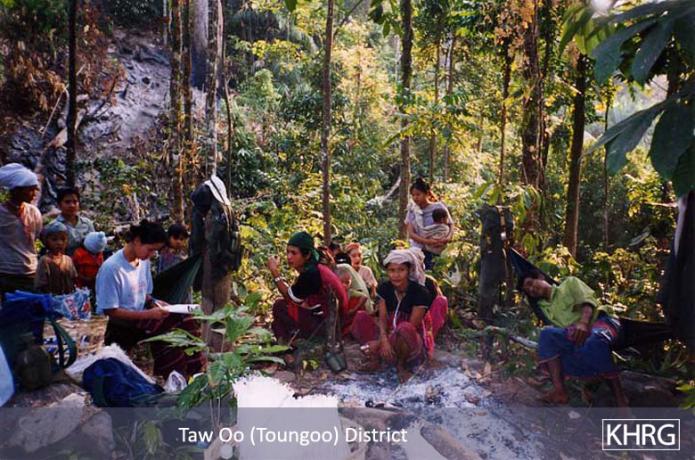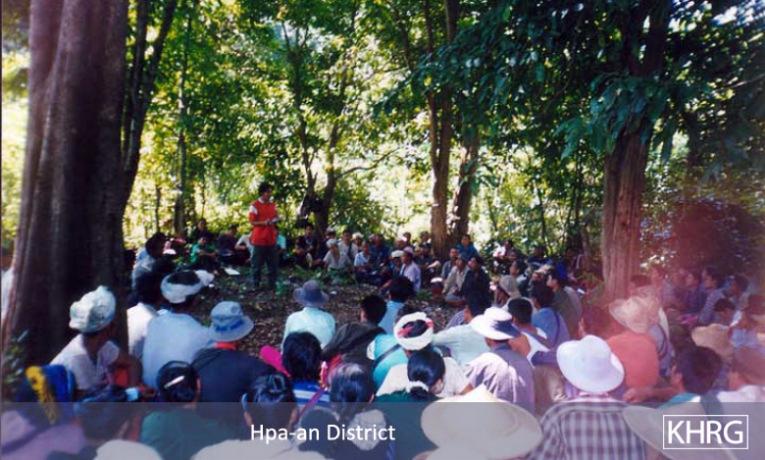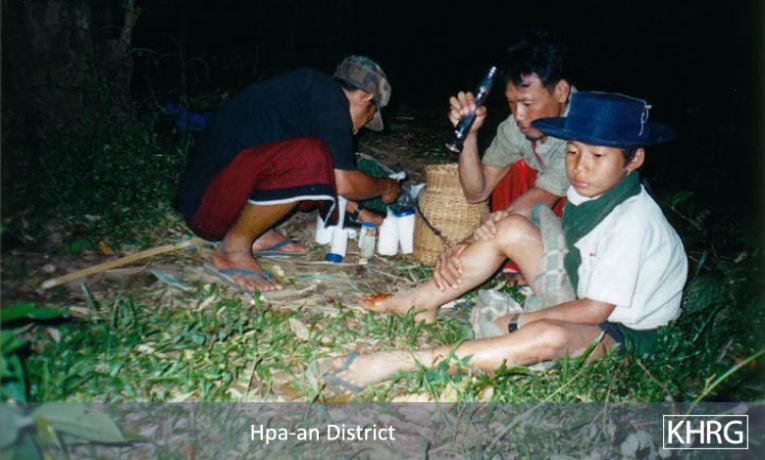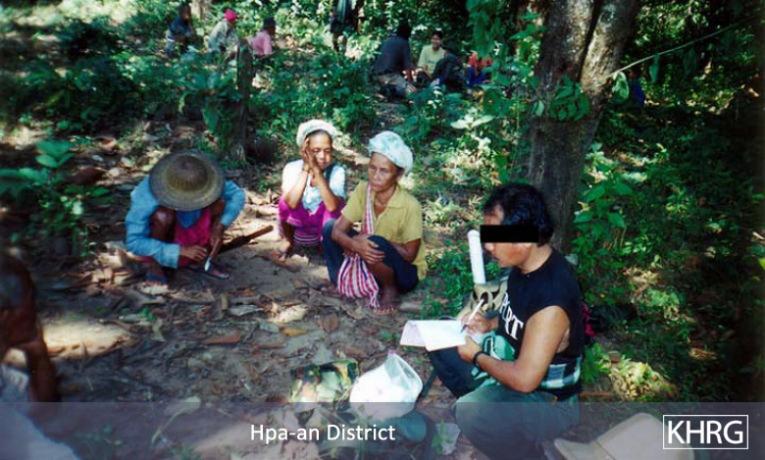Photo #7-44: Internally displaced women from P--- village in Bu Tho township, Papun District drying their cardamom harvest in January 2003 prior to taking it to market for sale. For IDPs living in hiding to avoid SPDC Army control, growing large fields of rice is too dangerous so they have to grow small-scale cash crops which they can sell to buy rice. [Photo: KHRG researcher]
Photos #7-45, 7-46: When these photos were taken in August 2002, these ricefields at L--- village in Lu Thaw Township, Papun District should have been full of growing rice. Instead, they have been abandoned by their owners, who have fled the area to avoid forced relocation by the SPDC. The fields and irrigation channels are now overgrown, a grazing ground for the buffaloes of people who are still willing to risk living in the area. [Photos: KHRG researcher]
Photos #7-47, 7-48: In 1997 the SPDC began construction on the Pwa Ghaw to Bu Sah Kee vehicle road to facilitate Army access to the hills between northern Papun and southern Toungoo districts ( see map ). These irrigated rice fields, which lie beside the road, were abandoned shortly thereafter because villagers feared being seen by the SPDC troops operating along the road route. Once construction began, villagers working these fields faced a high chance of being conscripted for forced labour on the road or as porters, or of being detained, beaten or shot at by passing SPDC patrols. The villagers therefore had to flee to areas away from the road route. These photos were taken in July 2002. Photo 7-47shows a field near Saw Mu Plaw village, and photo 7-48 shows a field at Htoh Law Plaw, both in Lu Thaw township of Papun District. The old rice has seeded itself and grows everywhere, even overtop the irrigation dikes. [Photos: KHRG researcher]
Photo #7-49: Hill fields of villagers from Meh Ta Kho Kee village in Dweh Loh township of Papun District. After clearing and planting the fields, the villagers had to abandon the crop when they fled due to increased SPDC activity in the area. This photo was taken in July 2002. [Photo: KHRG researcher]
Photo #10-22: A section of the road from Pwa Ghaw to Saw Hta in Papun district which SPDC forces bulldozed through the forest to give them a firmer foothold in the Papun hills. Since its completion in 2000, this road has made life much more difficult for villagers and displaced people in the area. Those with fields near the road route have had to abandon them, and those needing to cross the road to reach fields or food supplies take a risk of being shot on sight by SPDC patrols that frequently move along the road. As a result the entire area near the road has been largely depopulated. There is speculation that this road is also intended to facilitate SPDC militarisation of the Salween River to protect construction of the planned Salween dams. [Photo: KHRG researcher]
Photos # 7-50, 7-51, 7-52: Photos 7-50 and 7-51 taken in February 2005 can be viewed as a panorama from left to right (with some overlap in the centre); click here or on the above thumbnail to see the two photos assembled into a single panorama. Most of the flat land visible is farmland belonging to villagers in Thaton township, Thaton district, but it has now been confiscated without payment to establish a vast 5,000-acre rubber plantation for a Rangoon-based company called Max Myanmar. On December 3 rd 2004, the area was visited by representatives of Max Myanmar along with Lieutenant General Maung Bo, who is an SPDC member, and many of his soldiers. The villagers who had their land confiscated were told that the rubber plantations will be a joint venture between Max Myanmar and the Army. When these photos were taken, much of the land had been cleared in preparation, but no planting had occurred yet. In May 2005 the General visited the plantations with Max Myanmar once again, as reported on May 9 th 2005 by official newspaper New Light of Myanmar (English version): "At the briefing hall of Max Myanmar company which is engaged in growing 5000 acres of rubber in Shweyaungpya village in Bilin Township, U Zaw Zaw Chairman of the company [Max Myanmar] briefed Lt-Gen Maung Bo and party on cultivation of rubber. Lt-Gen Maung Bo urged officials concerned to extend cultivation of rubber in the interests of the State, the region and in their own. Next, they inspected rubber plantations by car. According to the rubber growing project of Max Myanmar, 1000 acres will be put under rubber in 2004-2005, 2000 acres in 2005-2006 and the remaining 2000 in 2006-2007." ("Lt-Gen Maung Bo inspects development undertakings in Mon, Kayin States", New Light of Myanmar , May 9 th 2005). No mention is made in the article of whose land this was. Along with the farmfields which have been confiscated, photo 7-52 shows a closeup of some of the scrubland which has been cleared, and two piles of cut trees which the villagers have gathered for firewood. The villagers always gathered firewood on this land, and told a KHRG researcher they fear that once the rubber is planted they will be kept out and will not have access to firewood or their fields anymore. Ironically, while not paying the villagers anything for their land, Max Myanmar is regularly cited in the New Light of Myanmar for donations to sports events and local education projects; company chairman U Zaw Zaw is also president of the Myanmar Tennis Federation, which organises local and international tennis events. O n February 4 th 2005, the company also donated 10 Million Kyat to "Tatmadaw families of regiments and units" in Irrawaddy Division ("Lt-Gen Khin Maung Than Oversees Development of Ayeyawady Division", New Light of Myanmar , February 5 th 2005). [Photos: KHRG researcher]
Photo #7-53: Officers from SPDC LIB #434 confiscated these irrigated ricefields from Naw S---, 40, of K--- village in Bu Tho township, Papun District. She received no compensation. This photo was taken at ploughing time in July 2004. In the foreground a buffalo can be seen attached to a plough, while in the distance some villagers from W--- village can be seen using their own buffaloes to do forced labour after being ordered to plough the fields for the soldiers. The villagers are also forced to plant, weed, and harvest the fields, but the soldiers take the entire harvest. [Photo: KHRG researcher]
Photos # 3-10, 3-11, 3-12: Photo 3-10 shows the relocation site in Nyaunglebin District where the people of G--- village (see photos 3-4 through 3-9 ) have been forced to live since February 10 th 2004. It lies along a roadside between two villages in what used to be irrigated ricefields, which flood in rainy season. To place the relocation site, the Army confiscated these ricefields without compensation from Saw H---, 70 ( photo 3-11 ) and Saw K---, 30 ( photo 3-12 ). Both men say that with the relocation site lying on their fields, they can no longer farm and have lost their livelihood. [Photo: KHRG researcher]
Photo #6-194: The outer perimeter of the SPDC Army camp at Htee Yu Thaw village in Kru Tu (Kyone Doh) township, Dooplaya District. This camp was built on the confiscated plantations of Saw P--- and Saw K---, neither of whom were compensated for the loss of their livelihoods. Lying in the foreground are the broken-down dikes of a number of irrigated paddy fields that were also destroyed in the construction of the camp. Every aspect of this camp was constructed using forced labour. The soldiers forced the villagers to build the soldiers' huts, dig the trenches and bunkers, and construct the fence visible in this photo. This is only the outer layer of three concentric rings of fence erected around the camp. Between each ring of fencing are rows of sharpened bamboo spikes planted as additional perimeter defences, all done by forced labour. This photo was taken in May 2003. [Photo: KHRG researcher]
Photo #7-54: This photo taken in March 2003 shows some of the rice fields along the Papun – Ka Ma Maung road belonging to Bweh Klah village in Bu Tho township, Papun District. Months before, however, the SPDC Army had forced Bweh Klah village to relocate elsewhere and seized these fields to grow food for themselves. [Photo: KHRG researcher]
Photo #10-24: These villagers from B--- village, Bu Tho township, Papun district left their village after SPDC troops set up a camp along the vehicle road nearby in April 2004. With the camp on the road, they said that they can no longer dare travel to town to get food or work farmfields anywhere near the road. In Karen hill areas, roads increase mobility for the Army but decrease it for villagers. [Photo: KHRG researcher]
Photos # 7-55, 7-56, 7-57: These photos show villagers from Mone township, Nyaunglebin District buying food and dry goods at a secret 'jungle market' where the villagers from the plains and SPDC-controlled villages can sell their goods to villagers and IDPs from the hills. In many areas across Karen State, the SPDC has prohibited trade between those who live in the plains and those who live in the hills, in an attempt to make survival unsustainable for IDPs and resistance forces. Unable to grow enough rice because ricefields are too visible to SPDC patrols, many internally displaced villagers have switched to small-scale forest cash crops like cardamom which they can then sell to buy rice; but they cannot dare enter SPDC-controlled villages to exchange their crops for fear of capture. 'Markets' such as this one are occasional, shifting and temporary and must be established with the utmost secrecy. If SPDC authorities were to find one of these markets, all of the villagers in attendance would be accused of being KNU sympathisers, and would be detained and possibly tortured or summarily executed. In photo 7-57 , a few KNLA soldiers are also buying goods. These photos were taken in October 2003. [Photos: KHRG researcher]
Photo #8-7: Civilians from Bilin town in Thaton District gathering rattan cane from the forest. With no work available in the town, these villagers must venture out into the forest to collect cane which they sell in order to buy rice to feed their families. This photo was taken in February 2004. Photo #7-58: Beginning in late 2003, DKBA #333 Brigade prohibited villagers living in Bilin township, Thaton District from going into the hills outside their villages, and began landmining the hills. This effectively blocked many villagers from farming their hill fields or gathering forest products. However, the people in this photo secretly grew a small plot of rice in the forest away from their village without the DKBA soldiers knowing about it. If they were discovered, they could be shot, detained or fined by the DKBA, but there is no other way to get food to survive. This photo was taken in November 2003. [Photos: KHRG researcher]
Photos #7-59, 7-60: In 1997 the SPDC forcibly relocated the villagers from Meh Kaw Law village to the Meh Way relocation site in Dweh Loh township of Papun District. Once they were relocated, the SPDC Army soldiers would not allow the villagers to return home to work these fields, fearing that they would go into hiding in the hills. These photos, taken in December 2002 and June 2003 respectively, demonstrate the progressive degeneration of unused ricefields, as the dikes erode and the fields silt up and become overgrown. These fields would now need major work before being usable again. [Photos: KHRG researcher]
Photos #7-61, 7-62: Villagers from M--- village work together to finish harvesting ricefields in Bu Tho township of Papun District even though SPDC soldiers are based nearby at T---. In this area villagers are often shot on sight, so the work must be completed quickly. Villagers are exposed and vulnerable in the fields, and SPDC troops often set ambushes by the fields at harvest time to capture or kill IDPs (as can be seen in Section 5, Shootings and Killings ). These photos were taken in November 2002. [Photos: KHRG researcher]
Photo #11-2: This signboard reads in Burmese, "Do not cut the trees; there are landmines" . It is posted beside the path that many villagers from the Kler Lah relocation site in Toungoo District must use to gain access to their plantations. Villagers from the area interviewed by KHRG stated that they no longer dared to return to tend to their plantations after seeing this sign. The planting of landmines on paths known to be frequented by villagers is a common tactic employed by the SPDC in preventing them from returning to their crops. In most cases, however, landmines are deployed with no warning being posted. This photo was taken in August 2002. [Photo: KHRG researcher]
Photo #7-63: These internally displaced villagers from M--- village in Dweh Loh township of Papun District are returning to their huts near their home village with rice that they have bought from a nearby village. Many IDPs must resort to growing small cash crops which they can barter or sell for rice, because open ricefields are too vulnerable to SPDC patrols. This photo, taken in July 2002, shows the villagers walking along a streambed so that they will not leave tracks which could be found by SPDC soldiers. [Photo: KHRG researcher]
Photos #7-64, 7-65: These villagers from the western plains of Tantabin Township in Toungoo District are transplanting paddy seedlings from the seedbed to the open field in July 2004. Though it looks idyllic, villagers in this area live under heavy SPDC control, and consistently complain that they are kept away from their fields so much by SPDC forced labour and extortion demands that they have difficulty producing a full crop. [Photos: KHRG researcher]
Photo #6-192: On April 21 st 2004, DKBA Ka Hsaw Wah ('White Elephant') Battalion Company #5 (Lieutenant Htoh Lweh commanding) ordered six villages in Dweh Loh township, Papun District each to send five villagers to build them a new Army post on the Papun - Ka Ma Maung car road not far from Ma Htaw village. The villages that were ordered to provide labour were Khaw Klah, Tha Ma Kyu Law, Ta Hu Law, Noh Pa Doh, Th'Waw Ko Law and Ma Htaw villages. Each household in these villages was also ordered to provide 50 lengths of bamboo and 15 shingles of roofing thatch for construction. The DKBA planned to use the new post as a checkpoint to exact tolls from every civilian vehicle passing along the road. They now demand 1,000 Kyat from each car/truck, 500 Kyat from each bullock cart, and 200 Kyat per motorcycle. SPDC and DKBA Army vehicles are, of course, exempted. It took 30 villagers three days to complete the work, yet not one of them received any form of recompense. This photo shows some of the piles of prepared bamboo and thatch which had been delivered to the site prior to the construction of the buildings in April 2004. [Photo: KHRG researcher]
Photos # 6-190, 6-191: A brick baking business controlled by LIB #376 (Major Aye Lwin commanding) in Pa'an township of Thaton District. Between March 1 st and 20 th 2004, Major Aye Lwin ordered the villagers of K--- village to bring enough loads of firewood to fire the brick kilns (some of the leftover firewood is visible in photo 6-190), and used his own soldiers as labour to bake the bricks for his personal profit. Not only were the villagers forced to work without pay but, adding insult to injury, they were forced to buy the bricks afterward at 15 Kyat per brick. These photos were taken in May 2004. [Photos: KHRG researcher]
Photo #12-14: In early 2004, DKBA #999 Brigade special battalion in T'Nay Hsah township of Pa'an District demanded three men per village for forced conscription as soldiers in the DKBA. Those selected who did not wish to become soldiers were required to pay a 30,000 Kyat fee for failure to perform their 'duty'. Saw P---, 49, from K--- village had to sell one of his cows in order to raise the necessary funds to avoid conscription. This photo was taken in May 2004. [Photo: KHRG researcher]
Photos # 7-66, 7-67: Villagers in Dweh Loh township of Papun District delivering food and materials demanded by Deputy Battalion Commander Thein Zaw of LIB #598 in July 2003. This time the officer's demands included rice, cooking oil, and other goods. Such demands are filled by sharing them out among each family in the village: either each person supplies a small amount from their own supplies, or the village leaders collect money from each household to buy the goods from one of the villagers or on the market. [Photos: KHRG researcher]
Photo #7-68: The DKBA produced this poster and forced every household under their jurisdiction within T'Nay Hsah township of Pa'an District to purchase a copy of it for 1,000 Kyat each. The poster reads: 'Number (999) [Brigade] Special Commando Battalion, Shwe Ko Ko, Myawaddy [township] ; Karen New Year Commemoration'. One villager who was forced to buy a copy told KHRG, "We had to buy it. After we bought it, we had to hang it in the house. [DKBA #999 Brigade Special Battalion commander, Colonel] Maung Chit Thu said he would go around and check. If he didn't see the picture, the owner [of the house] would have to pay 5,000 Kyat because they did not buy one and hang it up." This photo was taken in March 2003. [Photo: KHRG researcher]
Photos # 7-69, 7-70, 7-71: A timber mill worked by villagers from K--- village in Lu Thaw township of Papun District. The logs are milled in the forest and are later transported by bullock cart almost the full length of the district for sale, to Ka Ma Maung in southern Dweh Loh township where they sell the finished timber planks. They must pass through seven checkpoints manned by SPDC or DKBA soldiers along the way, each of which extorts a toll before allowing them to pass. These photos were taken in March 2003. [Photos: KHRG researcher]
Photos #6-40, 6-41: Villagers in T--- village, Lu Thaw township, Papun District gather to hand in their monthly 'porter fees' to the village headman. To avoid regular shifts of forced labour as porters, each house in the village has to pay 1,000 Kyat per month to Htun Neh Lay, commanding officer of SPDC IB #9 Column #1. Every village in the region has to pay similar fees to whatever battalions are nearby. These photos were taken in March 2003. Photo #6-99: A villager from M--- village in Bu Tho township of Papun District performing forced labour as a set tha('messenger') for the local SPDC battalion. Most villages under SPDC control are forced to send one or two villagers each day to each nearby Army camp to do forced labour as set tha . The officers use set tha people to run errands, deliver written SPDC order documents to recipient villages, fetch village leaders or goods demanded from villages, and lead SPDC patrols along pathways. In between these duties they are used for other errands such as fetching water, gathering firewood or standing sentry at SPDC Army camps. This villager is returning home from a nearby SPDC Army camp with a written order from the local officer demanding 10 viss [16 kg. / 36 lb.] of pork and one big tin [12.5 kg. / 28 lb.] of rice from the village. Orders such as these are regularly issued to all villages living under the control of the SPDC across Karen State. This photo was taken in March 2003. [Photos: KHRG researcher]
Photo #6-102: Naw P--- is a village head in Dweh Loh township of Papun District. She explained to a KHRG researcher how both the SPDC and the DKBA issue her village with order documents in which they state their demands. Her village must regularly provide the soldiers with food, building materials, extortion money, and villagers for forced labour. If they fail to comply, she and the entire village are punished. She is shown here holding some of those written orders sent to her village by the SPDC. Even these order documents are delivered by villagers doing forced labour as set tha . This photo was taken in December 2002. Photo #6-103: The village head of K--- in Papun district and a group of his villagers head for a meeting with SPDC officials in Papun town on October 29 th 2002. They had been ordered to attend this meeting and threatened with a cash fine if they failed to appear. The officials also demanded a chicken, which one of the villagers is carrying in the photo. Photo #7-72: U N---, a 73 year old fruit farmer from a town in Nyaunglebin District, is forced to pay tolls at each of the four SPDC Army checkpoints he passes through while taking his produce to market. At each checkpoint, the soldiers exact a toll of one Kyat for every two limes and three Kyat for every piece of bamboo that he is carrying. The checkpoints are manned by soldiers from IB #57, LIB #349, LIB #350, and LIB #440. This photo was taken in July 2002. [Photos: KHRG researcher]
Photos #7-73, 7-74: Saw K--- from Dweh Loh township, Papun District, owns two elephants which he uses to make his living by hauling things. In late 2002, DKBA officers from #777 Brigade ordered him to begin doing forced labour hauling logs for them; however, he was afraid to do this because the KNU had banned logging in his area. If he hauled the logs he would face arrest by the KNU, and if he didn't he would face arrest by the DKBA, so he left his village with his elephants. These photos were taken as he was leaving on November 11 th 2002. [Photos: KHRG researcher]
Photo #7-75: For this rice field near H--- village in T'Nay Hsah township of Pa'an District, the farmer must pay an annual crop quota of ten baskets [250 kgs. / 550 lbs.] of paddy per acre. This amounts to a significant portion of the harvest. Even if the villagers suffer a bad harvest due to adverse weather conditions, insect infestation, fire, or for any other reason, the SPDC authorities do not lower the quota; if the harvest is insufficient, villagers are expected to buy rice on the open market and hand it over. In addition, when the quota collection officials come around, they are expected to feed and fête them. This photo was taken in November 2002. In 2004 the SPDC claimed that it would scrap the crop quota system nationwide, but KHRG has not yet received any evidence of whether this has been done for the late 2004 crop. [Photo: KHRG researcher]
Photos #7-76, 7-77: Both of these men from northern Papun district were robbed at gunpoint by SPDC Column Commander Zaw Min of LIB #598 Column 2 based at Gkay Gkaw army camp. Saw M--- ( photo 7-76 ) says that in February 2005 Zaw Min stole his pigs and goats from his village. Saw K--- ( photo 7-77 ) met Zaw Min's column along a path on December 28 th 2004. Without saying anything, Zaw Min fired three gunshots into the ground at Saw K---'s feet, punched him twice in the face, and then stole his watch. [Photos: KHRG researcher] Photo #7-78: Saw R---, 58, from H--- village in Tantabin township, Toungoo District, described how on July 9 th 2004 a column from SPDC IB #60 led by Column Commander Hlaing Win Tint and Camp Commander Yin Soe looted his belongings including several gold rings and earrings, and destroyed his supply of fishpaste. [Photos: KHRG researcher]
Photos # 5-3, 5-4, 5-5: On December 20 th 2003, soldiers of SPDC IB #264 Column 1 (Column Commander Tin Maung Shwe commanding) led by officer Chit Hlaing encountered a group of four villagers from Toungoo District along their way. They detained all four men, looted their belongings and robbed the 100,000 Kyat in cash the four were carrying with them. They then tied the heads of the four men with cloth and beat all four of them to death with a stick. The victims were Saw Day Day, 30, and Saw Win Ni from Ma La Gone village; Saw Ni K'Ler, 20, from Peh Kaw Der village; and Saw Ba Aung, 30, from K'Thaw Kee village. They then buried all four men in a shallow hole together along with the cloth and the stick used to kill them. A KHRG researcher found and partially exhumed the grave in February 2004. Lying among the remains of the victims and their clothing, photo 5-3 displays the red bloodied cloth that was used to tie one of their heads before beating them with the stick. The stick used to beat them to death, still marked with the blood of the victims, appears in the foreground of photo 5-5 . [Photos: KHRG researcher]
Photo #10-77: Village secretary Saw P---, 32, from B--- village in Than Daung township, Toungoo district, was a leader in his SPDC-controlled village until troops from LIB #509 (Battalion Commander Nyunt Win commanding) looted his belongings, shot and killed his poultry and detained him arbitrarily in December 2003. After that he fled into the forest, where this picture shows him over a month later. [Photo: KHRG researcher]
Photo #7-79: On November 2 nd 2003, all of the villagers from B--- village in Bu Tho township, Papun District fled their village in advance of an approaching SPDC Army column. The column, composed of soldiers from LIB #341 and IB #35, arrived at the village two days later on November 4 th 2003. Finding the village empty, the soldiers slaughtered and ate a number of the villagers' pigs and chickens. Numerous piles of bones and feathers were found in the village after the soldiers had left, including this large pile of chicken feathers (foreground); in the background are ashes from fires used to cook the chickens and pigs. This photo was taken after the soldiers had withdrawn. See related photos 10-80 and 10-81 in Section 10. [Photo: KHRG researcher]
Photo #2-14: SPDC soldiers from IB #5 under battalion commander Ko Ko Naing built a temporary Army camp adjacent to the irrigated paddy fields of Htee Baw Law village in Dweh Loh township of Papun District. On May 15 th 2003, the soldiers entered the village and stole the thatch from the roofs of the villagers' homes for use in the construction of the camp. This photo was taken in July 2003. [Photo: KHRG researcher]
Photo #7-80: Naw M--- from T--- village in Dweh Loh township, Papun District, drying her paddy in January 2003. A few months earlier, soldiers from LIB #104 led by Column Commander Zaw Mine stole her chickens, ducks, and a large quantity of her paddy. She hopes the same will not happen to this new harvest. [Photo: KHRG researcher]
Photo #7-81: On September 17 th 2002, SPDC troops from LIB #3 Column #2 (battalion commander That Htun Aung commanding) entered K--- village in Dweh Loh township of Papun District and proceeded to loot the villagers' belongings. Forty-year-old Naw K--- objected when the soldiers began taking her food and clothing. One of the Non-Commissioned Officers slapped her in the face and hit her with the butt of his rifle. She did not dare to complain again. This photo was taken in October 2002. [Photo: KHRG researcher]
Photos # 10-82, 10-83, 10-84: On August 15 th 2002 soldiers from LIB #9 (deputy battalion commander Myo Myint commanding) arrived at T--- village in Bu Tho township of Papun District, causing the villagers to flee en masse into the forest. The soldiers remained in the village for the next two weeks, during which they lived off the villagers' food supplies. They emptied one rice barn containing over 100 baskets [2,500 kgs. / 5,500 lbs.] of rice and then half of another. They also killed and ate many of the villagers' chickens, goats, and pigs. Photos 7-82 and 7-83 show one of the emptied rice storage sheds, while photo 7-84 shows a pile of coconut husks discarded by the soldiers after stealing coconuts from the village trees. These photos were taken later in August 2002, after the soldiers had withdrawn. [Photos: KHRG researcher]
Photos # 7-85, 7-86, 7-87: Karen relief teams meeting with internally displaced villagers in the forests. Photo 7-85 was taken in Thaton District in April 2004, photo 7-86 in Thaton District in November 2003, and photo 7-87 in Papun District in September 2003. Relief teams such as this operate on only very limited budgets themselves and must travel great distances at considerable risk into the areas where IDPs are hiding to provide them with what aid they can. Note the stacks of Kyat notes at the feet of the man standing on the right in photo 7-86 addressing the group. Each villager at these meetings was given 4,000 Kyat with which to buy rice to feed their families. This money, however, is usually only enough to buy about two months worth of rice. Relief organisations such as this one are usually able to provide the villagers in some areas across Karen State with this sort of emergency support once every six months, but they remain under-resourced and cannot reach the majority of IDPs on a regular basis. As helpful as this aid is, it can only reach a small proportion of the ever-growing numbers of internally displaced villagers currently in Karen regions. [Photo: KHRG researcher]
Photo #10-143: Internally displaced villagers from all around gathered at this forest clearing in Lu Thaw township, Papun district on January 7 th 2004 to receive treatment from Karen medics. To the left, villagers are awaiting diagnosis. In the centre is the 'intensive care unit', where those on intravenous drips lie on a bed of rice straw. Photos # 10-144, 10-145: Internally displaced villagers who are ill in the forests of Toungoo district in January 2004 ( photo 10-144 ) and Papun district in March 2004 ( photo 10-145 ) receive medical care from Karen mobile medical teams. [Photos: KHRG researchers]
Photos # 10-149, 10-150: Members of 'backpack' medical teams operating covertly in Karen areas gather villagers to meetings to talk about health and to treat the sick in Pa'an District in mid-November 2002. [Photos: KHRG researcher]
Photos # 10-151, 10-152, 10-153: Medics from mobile medical teams treat internally displaced villagers in the forests of Pa'an District covertly in November 2002. [Photos: KHRG researcher]







































































